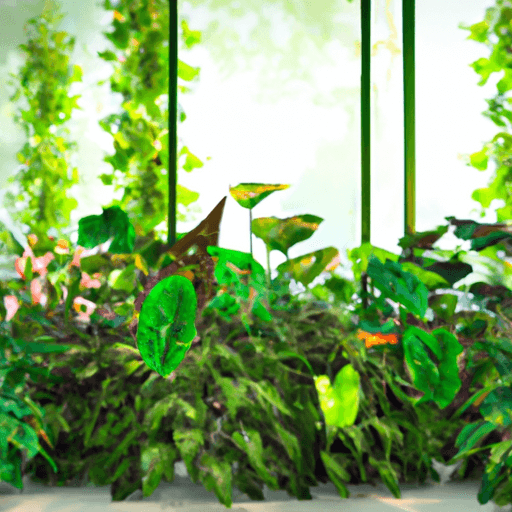Are you looking to successfully grow various varieties of philodendron plants indoors? Look no further! This comprehensive guide provides all the information you need to cultivate healthy and thriving philodendrons.
From ideal growing conditions and fertilization techniques to propagation methods and potting guidelines, this article covers it all.
Explore different types of philodendron varieties and learn how to manage pests, diseases, and common problems.
With these valuable tips, you’ll be on your way to indoor success with your philodendron plants.
Ideal Growing Conditions for Philodendrons
Philodendrons grow best in partial sunlight and need bright, indirect light, making it important to provide them with the ideal growing conditions.
When it comes to watering frequency, it is crucial to strike a balance. Water the plant when the top inch of soil has dried out. Overwatering can lead to root rot, while underwatering can cause wilting and stunted growth.
As for the recommended temperature range, philodendrons should be kept in temperatures above 55 degrees Fahrenheit. They prefer a warm and humid environment, so maintaining a temperature between 65 and 75 degrees Fahrenheit is ideal.
Fertilization and Propagation Tips for Philodendrons
Proper fertilization enhances the growth of philodendrons and can be achieved by using a balanced liquid fertilizer monthly during spring and summer. This ensures that the plants receive the necessary nutrients to thrive.
When choosing a fertilizer for philodendrons, it is important to select one that is balanced and specifically formulated for houseplants. Look for fertilizers with equal N-P-K ratios, such as 10-10-10 or 20-20-20, as these provide a good balance of nitrogen, phosphorus, and potassium. These nutrients are essential for healthy plant growth and development.
In addition to fertilization, philodendrons can be propagated through practical methods such as stem cuttings or division. Stem cuttings can be placed in water to develop roots, while division involves removing plantlets with roots from the main plant. These propagation methods allow for the expansion of your philodendron collection and can be done in early spring for best results.
Exploring Different Types of Philodendron Varieties
With a stunning array of foliage colors and shapes, philodendrons offer a diverse range of options for plant enthusiasts. Whether you prefer climbers, hybrids, or large plants with deeply lobed leaves, there is a philodendron variety to suit every taste.
Here are some different ways to display philodendron plants and unique care requirements for specific philodendron varieties:
- Use a trellis or moss pole for climbing varieties like Philodendron scandens and Philodendron erubescens.
- Showcase the velvety leaves of Philodendron melanochrysum in hanging baskets or on shelves.
- Opt for a compact hybrid like Philodendron rojo for tabletop or desktop displays.
- Create a dramatic statement with the large, lacy leaves of Philodendron bipinnatifidum as a floor plant.
- Experiment with different containers, such as terrariums or decorative pots, to highlight the beauty of each philodendron variety.
Remember to adjust watering, sunlight, and humidity levels according to the specific care requirements of each philodendron variety to ensure their success in your indoor space.
Potting, Repotting, and Overwintering Techniques for Philodendrons
To ensure healthy growth and prevent root bound plants, gardeners should repot their philodendrons when the roots start poking up from the soil and out of the drainage holes. This is typically done in late spring or early summer.
Repotting frequency for philodendrons is generally every couple of years, but it can vary depending on the size and growth of the plant.
When repotting, it is important to choose the right potting soil for philodendrons. They prefer loose, acidic soil that is rich in organic matter. A good potting mix for philodendrons can be made by combining equal parts peat moss, perlite, and vermiculite. This mixture provides good drainage and aeration for the roots, which is essential for the health of the plant.
When repotting, it is also important to choose a slightly larger container with ample drainage holes to accommodate the growing roots of the philodendron.
Managing Pests, Diseases, and Common Problems in Philodendrons
Aphids, mealybugs, scale, thrips, and spider mites are common pests that can affect the health of philodendrons. To effectively manage these issues, there are several methods you can employ.
-
Controlling pests: Regularly inspect your philodendrons for any signs of infestation. If you spot pests, you can try using a mixture of water and dish soap to spray and remove them. Alternatively, natural insecticidal soap or horticultural oil can be effective in eliminating pests.
-
Treating diseases: One common disease in philodendrons is mosaic virus, which can be identified by small yellow lesions or patterns on the leaves. To manage this, remove the affected leaves and apply a diluted nitrogen-rich fertilizer to help the plant recover and grow stronger.
-
Addressing common problems: Yellowing leaves, root rot, and browning leaves are common issues in philodendrons. Adjusting watering, sunlight, and humidity levels can help resolve these problems.







